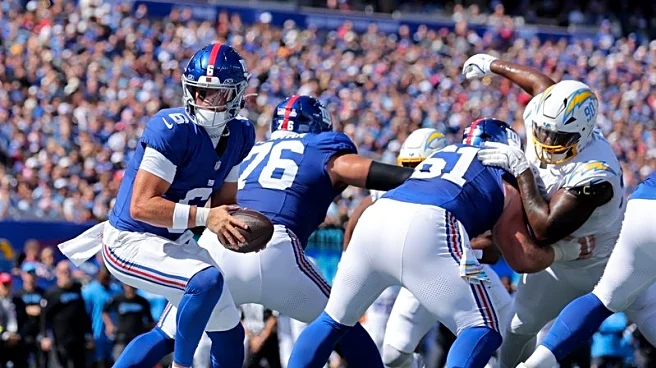With the first month of the season coming to a close, the Steelers are once again in familiar territory. Despite being a trendy pick to miss the playoffs by NFL pundits, and plenty of frustration from
the hometown fanbase, Pittsburgh has done enough to start the season 3-1 and take an early lead in the AFC North. If not for a red zone interception and a bizarre kickoff blunder in Week 2, the Steelers could very well have been undefeated heading into October.
It’s reminiscent of last season, when the Steelers also finished September 3-1 and saw the Ravens and Bengals falter out of the gates. This time, things are even worse for the Steelers’ rivals. Lamar Jackson is set to miss a few weeks for 1-3 Baltimore, and 2-2 Cincinnati has looked toothless in two straight losses since Joe Burrow was sidelined for at least three months with a major toe injury. The Ravens’ next two games will come against the Texans and Rams, while the Bengals will get the Lions and Packers before their first meeting with the Steelers.
Imperfect as they may be, the Steelers have a real opportunity to make a run at the division title.
If you’re a glass-half-full type, the Steelers being on pace to have a home playoff game is all you can ask for this early in the season. If you more commonly find your glass-half-empty, there are plenty of flaws with the roster and staff to point to, not to mention that the combined record of the three teams the Steelers have defeated is 4-8.
Regardless of which you are, October will be a pivotal stretch for the black and gold. With the Ravens vulnerable and without Jackson for a handful of games, and the Bengals floundering without Burrow, the Steelers need to take advantage. Win, and hopefully the Steelers will build a big enough lead that their rivals won’t be able to dig themselves out.
That effort will begin next week, with the Steelers on bye following their trip overseas.
In the meantime, let’s take a look at some developments from the Steelers’ win over the Vikings.
The Steelers are dealing with their own injury issues. How will the Steelers handle the absences of Jalen Ramsey and Calvin Austin?

RB: With Gerry Dulac reporting that both Ramsey and Austin are expected to miss “at least several games,” it will undoubtedly place stress on both sides of the ball for Pittsburgh.
Ryan will cover what Austin’s potential absence could mean; I’ll cover Ramsey’s. The latter should be an easier fix for the team given the good cornerback depth the Steelers built over the offseason.
Brandin Echols has been great covering for the team’s cornerback injuries so far this year, putting together starting-caliber play on both the boundary and in the slot. He’s a versatile player who can fill in for some of Ramsey’s versatility. With Joey Porter Jr. due for a return after the bye, the Steelers will be able to place Echols in the slot as Porter and Darius Slay handle outside duties. That’s still a good trio even if Jalen Ramsey’s play will be missed.
When the team is in base defense (when Ramsey generally plays free safety), the Steelers will be dealing with a more notable downgrade in Juan Thornhill. But the Steelers play their free safeties so far back that even Ramsey hasn’t been much of an impact player when in the middle third.
The biggest concern, of course, is if cornerback injuries continue to pile up while Ramsey is out. Given the team’s history early this season (both Echols and Slay missed time versus the Vikings), it’s a real possibility. However, James Pierre has looked solid on the boundary so far this season (even recording a near-interception in a great play near the end of Sunday’s game), and Beanie Bishop Jr., although not an ideal starter, remains a slot corner with some starting experience on the Pittsburgh practice squad.
Ramsey has been good for the Steelers so far in 2025, but the team is built to survive injuries in the secondary. I wouldn’t get too worried about his potential absence. Unless even more injuries pile up or Ramsey ends up on injured reserve, I don’t foresee the Steelers needing to make any moves.
RP: It’s no secret that the Steelers are desperately thin at wide receiver. If Austin were to miss an extended period of time, Scotty Miller would fill in for his punt return duties, and some combination of Miller, Ben Skowronek, and Roman Wilson would be in line to see an increase in reps. Miller and Wilson both have similar speed to Austin, but neither has produced much in their career to convincingly fill in as the number two receiver. Skowronek seems to have a good rapport with Aaron Rodgers and is easily the best blocker of the trio. I’d expect his snaps to go up the most.
Thankfully, it’s starting to sound like we might not see Austin miss much time at all.
Injuries can be tricky, and there could be any number of setbacks that develop between now and the next time Austin takes the field. However, if Austin is able to return healthy after the bye, or perhaps only miss one game, that would be the biggest boon for the Steelers.
They could also try to replace some of Austin’s production with one of their highly paid tight ends. Speaking of…
What’s going on with the Steelers’ tight end usage?

RB: In case you missed it, Steelers offensive coordinator Arthur Smith did some of that thing that the Pittsburgh coaching staff rarely gets much credit for: gameplanning. Against the Vikings on Sunday, Smith took Brian Flores’ defense by surprise with heavy usage of a jumbo package on offense.
The two stars of that gameplan were extra offensive lineman Spencer Anderson and tight end Darnell Washington.
Washington played a whopping 48 of the Steelers’ 53 offensive snaps (around 91%) after playing just 20 snaps against the Patriots the prior week (37%).
That, in turn, changed how the Steelers used their other three tight ends. Against the Vikings, Connor Heyward played 16 snaps, Pat Freiermuth played 15, and Jonnu Smith had 13. But against the Patriots, they had played one, 38, and 45, respectively.
That change has sparked some discussion online about just how the Steelers should use their tight ends.
If anything, I think Sunday’s game showed how each Steeler tight end has a distinct skill set, which I’ll dive into below.
But I’ll preface my thoughts with a quick caveat: I don’t think the Steelers’ tight end usage on Sunday necessarily signals a huge change in offensive philosophy. It was a one-off outlier compared to the rest of the season.
Of course, the Pittsburgh offense, namely the run game, looked the best it has all year. So some things could, and probably should, change more permanently. But I don’t think we’ll be seeing Darnell Washington playing 33 more snaps than Pat Freiermuth every week.
But that isn’t to say Washington didn’t look like a player who could help the team with a bigger workload moving forward. It’s hard to overstate just how valuable he is as a run-blocking tight end on the field. While he isn’t perfect (and in many cases, a tick late off the snap), his ability to handle edge rushers one on one in the run game is a massive help to the Pittsburgh offense.
And sometimes, that defensive end was the excellent Jonathan Greenard, who Washington still managed to handle on Sunday. His ability to control the edges in the run game opened up the perimeter for the Steelers, playing into Kenneth Gainwell’s strengths as a runner and Arthur Smith’s outside zone philosophy as a whole.
And generally, it wasn’t just Washington using his size advantage for a quick pop backwards; he was sustaining his blocks as well.
Washington is easily the slowest pass catcher on the Steelers roster, but his presence on Sunday wasn’t an indicator that it was a run play. Washington recorded a respectable three catches for 20 yards against the Vikings. With his size and sure-handedness, he’s a real security blanket beyond his obvious red zone savvy. Plus, he has the sort of frame that makes him an automatic yards after catch threat — as in, he rarely goes down on first contact even if he won’t be breaking off big plays.
In short, Washington played TE1 snaps on Sunday and showed he can handle the dual nature of the role, even if he’s significantly better at one than the other. But blocking tight ends are in vogue in the current NFL. It’s a skill set the Steelers can succeed with.
But what about the rest of the team’s tight ends?
For one, I think that part of the reason why the Spencer Anderson-led run game was so successful against the Vikings wasn’t just because Anderson played well and jumbo O-line packages tend to help on the ground game. It’s also because Anderson was replacing a tight end on the field.
Outside of Washington, I wouldn’t describe any of the Steelers’ tight ends as high-end blockers. Pat Freiermuth is who I’d argue as the second-best on the roster in that regard, as he’s generally a bit better in-line than people think.
He clearly plays with effort, and has what it takes to make impactful blocks from time to time:
But the Minnesota game showed some of the good and more of the bad of what Freiermuth brings to the table. In the first two reps below, he initially whiffs or peels off his blocking assignment. It’s a recurring issue:
But when he does connect, like in the last play above or the block with Connor Heyward below, he’s certainly a serviceable blocker.
He can get things done, but he isn’t a reliable piece in the ground game. And if you’re going to be an every-down tight end in the Arthur Smith scheme, that’s a problem.
But that’s certainly not to say that Freiermuth is useless in the offense. He hasn’t been a featured player much in the passing game, but he’s still a good contributor there. You can even refer back to the first clip of the Darnell Washington catches compilation and see the pure speed difference as Freiermuth opens up space for Washington.
He’s still the most complete tight end on the Steelers roster. The problem is that the other three on the team all fill their respective roles a bit better: Washington is the best blocking guy. Jonnu Smith is the best pass-catching guy. You get the idea.
Speaking of Jonnu Smith, he also had a quiet game against the Vikings, with just two catches for six yards. But he fills a role in the Steelers offense, with the team even motioning him in and out of the backfield at times to capitalize on his yards after catch ability – a crucial skill to have in the team’s short passing game.
I’m on the record writing that Smith is an impressive athlete who has been a plus addition to the team’s passing game.
But the flip side is that Smith is by far the worst of the tight end room’s blockers.
The Steelers actively avoid putting Smith in positions where he has to block, especially any plays that rely on his blocking to succeed. He’s a good talent, but far more of a gadget player than a traditional tight end.
Then there’s Connor Heyward. To refer back to each tight end’s role, Heyward’s is even more niche. He’s Arthur Smith’s split zone guy.
Split zone, which is a zone play in one direction with a tight end or H-back pulling in the other (my full breakdown can be read here) is an Arthur Smith staple, and even on non-split zone plays, Heyward is often a bit behind the line of scrimmage in a two point stance and doing something in motion.
Heyward is another Steeler who I think gets a bit too much hate compared to who he actually is as a player. It’s a little easier to see from the skycam view, but in the first clip in the video above, he actually does just enough to get in the way of the blitzing linebacker as he moves across the formation, stopping two defenders from making the tackle on the same play.
Heyward is still not the most physically-imposing tight end, however. In the below play, you can see a Minnesota defender get wise as to what the play is, and Heyward can’t do much to stop him. He’s certainly a limited player as well.
To summarize, what makes the Steelers tight end room fun is that you have four very distinct players. That allows Arthur Smith to get funky with various play calls, from tush pushes with Connor Heyward to jet sweeps with Jonnu Smith. Pittsburgh’s 13 personnel can do so much more than what 13 personnel traditionally signals.
But that strength is also a weakness, as none of the Pittsburgh tight ends are that interchangeable with one another. To make a more run-heavy offense work against Minnesota, the Steelers could really only rely on one of the four to play the majority of snaps. Darnell Washington had a great game; Freiermuth and Smith largely disappeared as a result.
Ryan will break down the Steelers’ run game success against the Vikings more in depth below, but that’s my main worry regarding them sustaining the progress they made against Minnesota. It was a great gameplan by Arthur Smith — don’t get me wrong! But right now the team has only proven it can run the ball well with one tight end and six offensive linemen. How much can you build on that?
But also, as Ryan mentioned in the first question, Jonnu Smith and Pat Freiermuth’s receiving ability also means they can step up in the passing game and provide good fill-in play if the team gets thin at wide receiver.
It’s a weird tight end room, and that comes with a unique set of strengths and weaknesses. Arthur Smith is continuing to find out how to best put them in places to succeed — and more importantly, not fail.
A new running game wrinkle?

RP: As Ryland alluded to earlier, the biggest shakeup with the offense this week was the heavy use of a jumbo package that featured Spencer Anderson functionally serving as a sixth offensive lineman while lining up like an in-line tight end. This isn’t exactly a new grouping from offensive coordinator Arthur Smith, but it hasn’t been as much of an emphasis as it was against the Vikings.
Excluding quarterback scrambles, kneel downs, and a Connor Heyward tush push, the Steelers ran the ball 25 times against the Vikings. Of those play calls, 13 featured the jumbo package. Anderson and Washington were practically tied at the hip on these plays, as their assignments were side-by-side on eight of these rushing plays.
All told, seven of the jumbo package rushing attempts went for six-plus yards, and an eighth play was a four-yard touchdown.
The rushing splits for the game are pretty eye-opening as well. On rushing attempts without a sixth offensive lineman, the Steelers averaged 4.08 yards per carry on the day. That sample includes a 1-yard touchdown run, it should be noted. With that run excluded, the Steelers had a more respectable 4.36 YPC. But when they added the extra lineman, that number jumped to 5.54 YPC.
Part of the reason this personnel grouping was so successful against Minnesota was because of how the Vikings like to run their defense. Minnesota likes to run a lot of two-high safety looks, and they’ll often have five defensive backs on the field. This can present the offense with some light boxes to run against, which plays into the favor of zone-heavy schemes like the Steelers.
When the defense presents a light box, it’s easier for the blockers to find their assignment and win the numbers game. Early in the rep, the line can impose its will with some well-executed double teams that allow one of the blockers to then climb to the next level and take on linebackers and defensive backs. On the other hand, heavier boxes are harder to run against, simply because the blockers have to account for more defenders. To drastically oversimplify, this can limit the amount of double teams and overall push the line can create for their running back.
The Vikings did start to place more defenders closer to the line of scrimmage as the game wore on, but the Steelers were still mostly able to find success thanks to the extra tonnage up front and the play of Kenneth Gainwell. Gainwell was patient and had an effective jump cut that helped keep defenders off balance and the Steelers mostly ahead of the chains.
Of course, it wasn’t as simple as just putting six linemen on the field. The Steelers were better using this personnel grouping, but it wasn’t an automatic success by any means.
Still, it’s encouraging. The Steelers’ staff is often criticized by the fan base for being slow to adjust, so it’s nice to see them develop a game plan that works effectively against an opponent’s tendencies and utilize their personnel in ways that don’t feel like forcing a square peg into a round hole. Giving Washington the majority of the reps on Sunday because of this grouping makes a ton of sense because he is the best blocker among Pittsburgh’s tight ends.
I’d still like to see a little less of Connor Heyward’s attempts at blocking if I’m being honest, but it’s not like Freiermuth or Smith are strong blockers either. Bickley is a bit more generous with his assessment of Freiermuth than I am, and even he notes there are reps where Freiermuth appears willing, but is simply inconsistent with his execution.
But there’s room to incorporate both Smith and Freiermuth into the jumbo package. If the Steelers want to continue finding success with it, they’ll need to incorporate more passing plays to make it less predictable. The Steelers passed four times out of it on Sunday, targeting Metcalf twice and Gainwell twice. None of these were explosive passing gains, but they gained a respectable amount when you consider that two of them came on first down and another on second and short.
If Arthur Smith wants to get his other tight ends some easier touches, getting creative with the jumbo package passing game might be the way to go.
Join in on Steelers R&R by sharing your takes on this week’s topics. What are your thoughts on how the Steelers will deal with Calvin Austin and Jalen Ramsey’s injuries? Is the team’s run game and tight end room trending in the right direction? Feel free to pitch future questions in the comment section or on Twitter/X: tag @_Ryland_B or @RyanParishMedia, or email us at steelersreadnreact@gmail.com.











